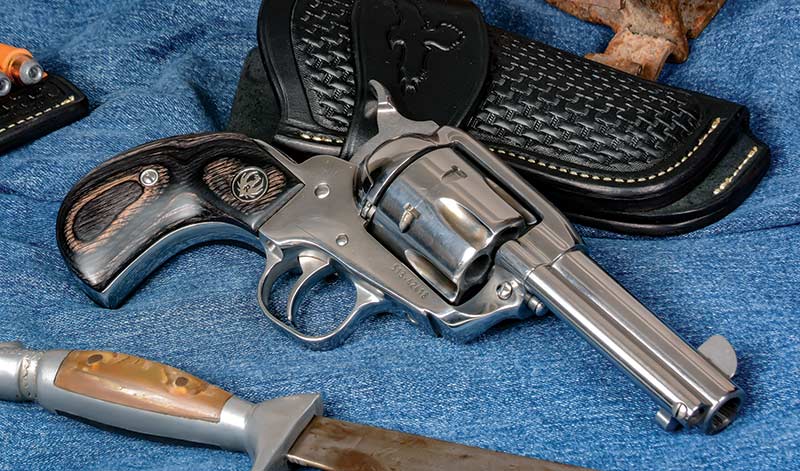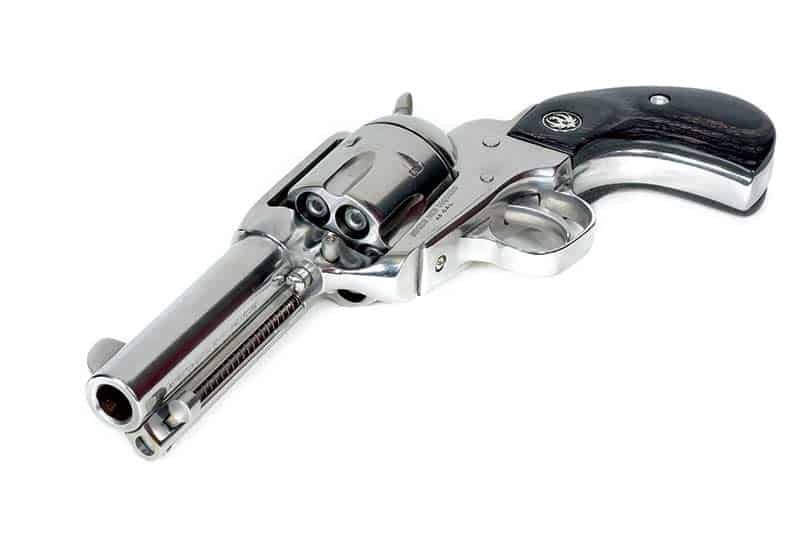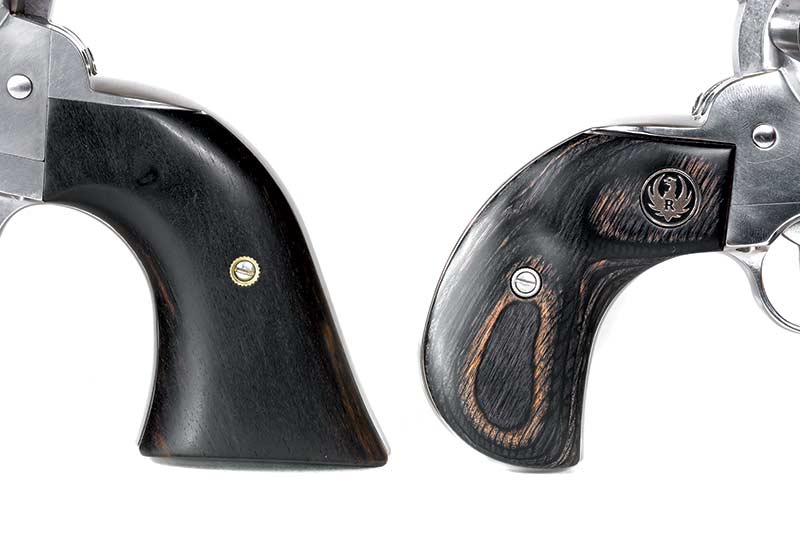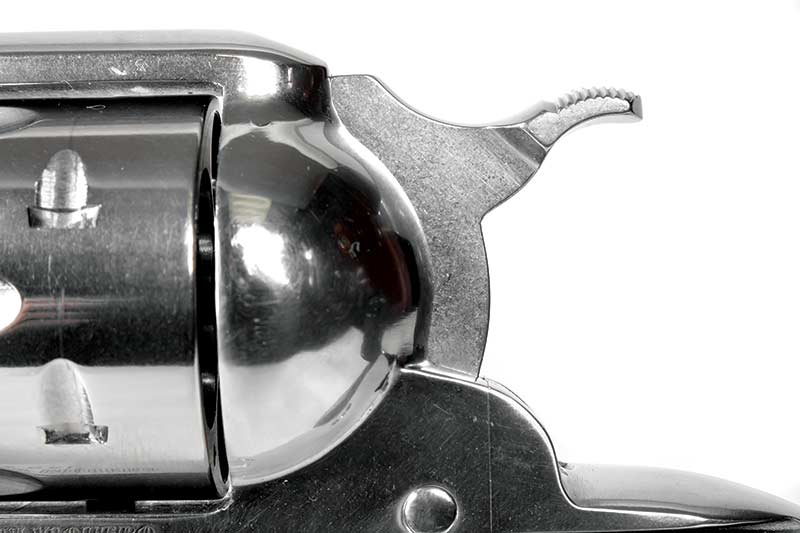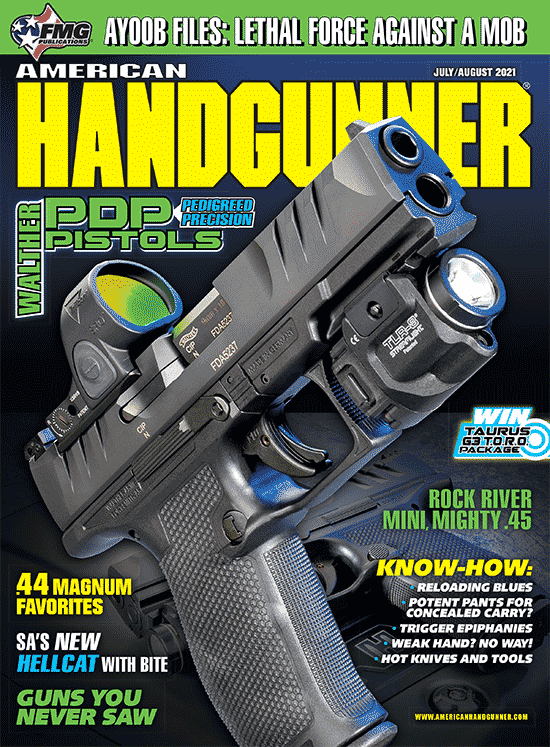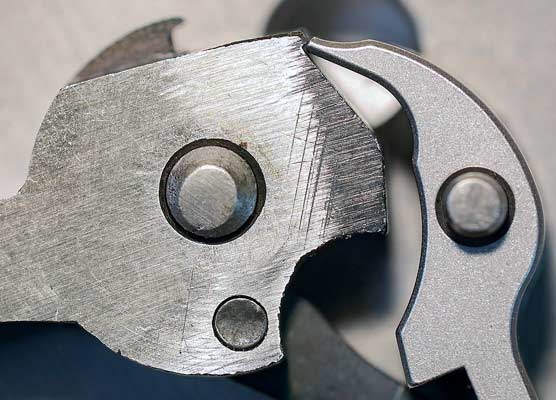Short & Sweet
Ruger’s 5151 Birdshead Vaquero
It wouldn’t be fair to say Ruger was built on the single action, but it wouldn’t be entirely inaccurate either. William B. Ruger formed a partnership with Alexander Sturm, an artist and a bit of a polymath who had been an OSS officer and married Teddy Roosevelt’s granddaughter. He provided the funding to support Ruger’s ingenuity.
Together, Sturm and Ruger introduced the stunningly successful and aptly named Standard .22 pistol in 1949. Combining elements of the Luger, Nambu and other pistols, it has since evolved into the current Mk IV and remains the standard for general use .22 LR pistols. The Standard was quickly followed by a trio of single action revolvers: the .22 caliber Single Six (1953), the Blackhawk .357 Magnum (1955) and the Super Blackhawk .44 Magnum (1959). All of these were well received by a market acculturated by Western movies and fast draw, but largely deprived of new production sixguns due to Colt’s suspending SAA production after WWII.
When Bigger Is Better
The Ruger revolvers were more than just copies of the SAA. They were re-engineered with things like coil springs that made them more reliable, and they were stronger than the guns upon which they were patterned. Later versions also incorporated a transfer bar internal safety making them safe to carry with a full cylinder. They also had adjustable sights, which greatly improved practical accuracy, but barred them from use in the fledging sport of Cowboy Action Shooting, which allowed only traditional-style fixed sight pistols.
Until late 1992, that is, when Ruger first displayed the fixed-sight Vaquero. Brought from idea to production in a speedy four months, the “Vaq” retained the advances of the Super Blackhawk while eliminating its Dragoon-style square back triggerguard and adjustable rear sight, resulting in a gun suitable for the SASS.
Chambered initially in .45 Colt blued guns had their receivers finished in a mottled pattern that mimicked color case hardening. Instead of the usual brushed finish, stainless Vaqueros received a polished finish reminiscent of nickel. While the actual polishing process was proprietary when the Vaq was introduced, the appearance of the finish suggests a tumbling process.
With a larger frame and cylinder than the SAA, the original Vaquero was far stronger than its inspiration. The strength, though, carries a weight penalty, which also affects the gun’s balance. Ever responsive to customer feedback, that led to the introduction of the trimmer, lighter New Vaquero. In addition to a longer frame window, the cylinder of the early .45 Colt Vaq is visibly larger (about 0.090″ longer and 0.050″ wider) and has thicker cylinder walls, weighing some 11/2 oz. more than the cylinder of the New Vaquero in the same caliber.
The .45 Colt is really two cartridges: the earlier, blackpowder-spec load and the hotter +P rounds that crowd .44 Magnum territory. Those like me who carry a .45 Colt for bear defense appreciate the early Vaq’s ability to safely shoot +P loads that shove 335-grain solids out at a thumping 1,100 fps. The New Vaquero, however, is not intended for this kind of use and should not be fired with the heavy +P loads you often see marketed as “Ruger Only” or such. Stick with standard pressure in the new model.
The 5151 Saddles Up
Into the smaller, livelier world of the New Vaquero comes the 5151, a stainless birdshead-style New Vaquero available exclusively from Talo. Featuring a 33/4″ barrel, rounded grip and slightly lower hammer, the 5151 in .45 Colt creates a nice, compact package that tips the scales at 37 oz. For comparison, a Super Blackhawk .44 Magnum with a 45/8″ barrel weighs half a pound more. Sights are, of course, the traditional groove-and-blade arrangement.
Neither birdshead grips nor short barrels are anything new on single actions. The mechanical problem with the latter is a short barrel leaves little room for an ejector rod, since the travel of the ejector rod is limited by barrel length at the front and the cylinder base pin on the rear. On a short gun, the operating tab on the ejector rod hits the end of the cylinder base pin before the rod can stick far enough through the chamber to do much good.
A single action is nobody’s idea of a speedloading gun — there’s a reason people carried two — but still, reloading the gun is even more difficult when it requires separate tools. Ruger addresses this custom, one best honored in the breach, by including a muzzle-length ejector rod housing on the 5151 and shortening the head of the base pin to make room on the back end. It makes a big difference: The tiny button lets the ejector rod stick some 0.543″ out of the cylinder, enough to push empty cases some 0.714″ out. No doubt, that’s short — the ejector rod of a 45/8″ .44 Special Blackhawk I had on hand protruded over 0.950″ — but it was adequate for my use. The two Bowen custom Rugers I measured (a 4″ lightweight Vaquero and a 45/8″ Super Blackhawk with the massive Keith #5 base pin) both have less protrusion, and I have quite a few rounds through them without extraction problems.
Grip panels are a bolt-on wood laminate with an attractive mix of darker and lighter grey-brown layers. Unlike palmswell grips, the panels are narrow in the middle, giving the middle finger of the shooting hand extra purchase on the gun. Conceptually it’s similar to the divot Bob Lum used to leave on knife handles, and it works equally well. The front of the cylinder has a heavy bevel reminiscent of the blackpowder bevel, which is a nice aesthetic touch and aids in holstering. Although hard to photograph, the bore was impressively bright.
Installing a lower hammer, such as one from a Bisley, is an old-school trick to make a single action faster to cock, a trick well known enough to have appeared on Elmer Keith’s iconic #5 revolver. While shooting a sixgun two-handed, cowboy action style, can benefit from the taller hammer, one-handed work will make you appreciate the lower spur — and lots of us aren’t willing to bet you’ll have both hands free when you need a gun. The 5151 doesn’t have the super low Bisley hammer, but it also doesn’t have the tall “longhorn” hammer of the Vaquero and Blackhawk. Instead, the hammer more closely resembles the lower profile of the Super Blackhawk, which is between the two, with a wide, serrated thumb pad that’s easy to hit. The trigger broke at an average of 4.5 lbs. as measured on a Lyman digital scale from Brownells.
The end result is a pretty, compact, solid feeling sixgun that slips easily into the hand, points well and doesn’t require undue effort to cock. Complaints? Although the mounting screw was tight, there’s a bit of play where the front end of the ejector housing mounts to the barrel. The action was a little sticky when the gun first arrived, but this went away immediately during the first range session. Sometimes you do just have to shoot the gun.
Making Smoke
I fired some 200 rounds through the 5151, including 255-grain semi-wadcutters and 250-grain semi-jacketed hollowpoints from DoubleTap ammunition, as well as handloads of mixed bullet type, provenance and quality. As expected, there were zero malfunctions, and recoil was surprisingly mild. The semi-wadcutters recoiled noticeably more than the hollow point rounds, but neither was unpleasant. The birdshead grip is significantly smaller than the traditional sixgun handle, but I had no trouble hanging on to it. Recoil seemed to drive the gun directly back into the palm instead of flipping the muzzle up, but that’s only based on the way it felt to me; your mileage may vary. I was able to shoot groups in the 31/2″ range at 25 yards, but most of this is probably limited by the bright stainless sights. With darker sights, which are easier to align, the gun is capable of tighter groups.
Gunleather
A good gun needs good leather, and a sixgun in particular needs something with a bit of Western flair. As has become my wont, I reached out to Mike “Doc” Barranti of Barranti Leather. Those of you who listen to the podcast will know he got the nickname “Doc” from our own Tank Hoover; in any event, you should know Doc has been making holsters for around 35 years and he is very, very good at it. He made one of his Ranger holsters for the 5151, along with a matching cartridge slide to hold six spare rounds. Both are made of black leather and stamped in the basket-weave pattern used on the Brill holster, after which the Ranger is patterned. Doc also stamped the cuff of the holster with the Gunsite Raven at my request. Unlike the movie-inspired Buscadero gunbelts, the Ranger holds the sixgun up high and tight, where it can be concealed, which is appropriate for a chopped-and-channeled hogleg like the 5151. Together, they make a very classy combination, and one I like enough to keep.
Unfortunately, I’m one of those people who can’t leave a sixgun well enough alone, so I’ve already talked to Hamilton Bowen about sending this 5151 up to Tennessee for a little extra attention. I’ll keep you posted.
For more info: DoubletapAmmo.com, Brownells.com, BarrantiLeather.com, Ruger.com

